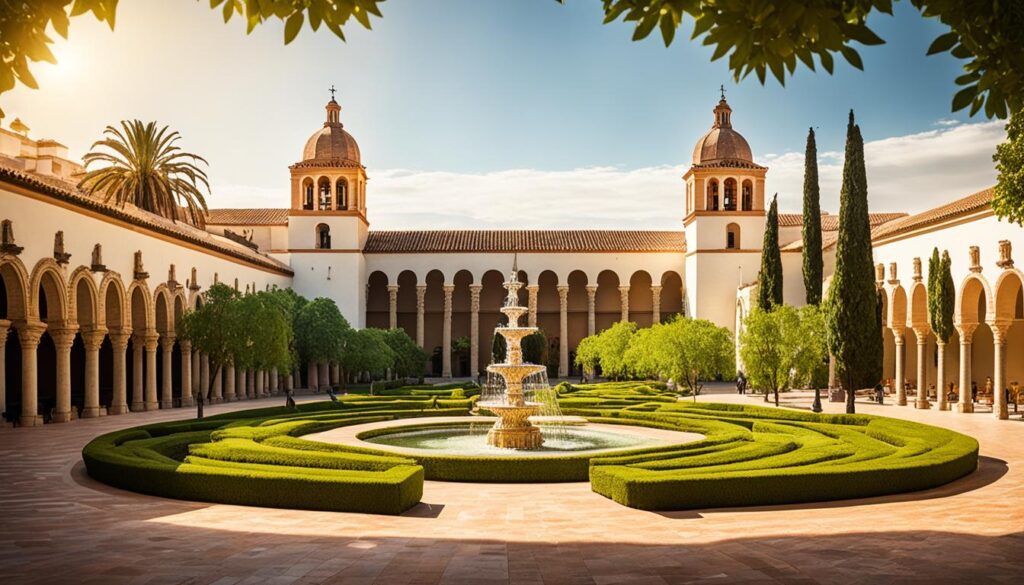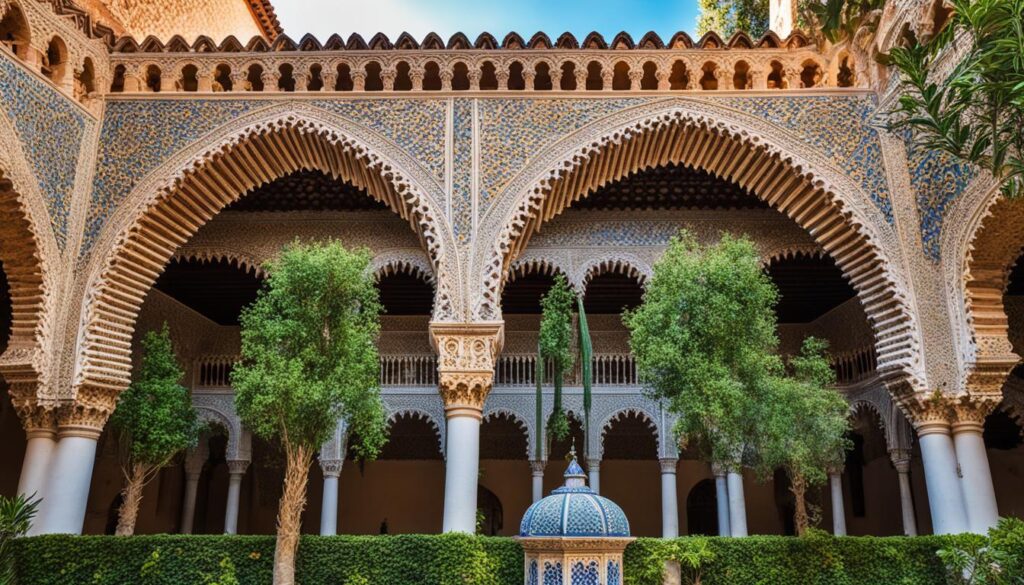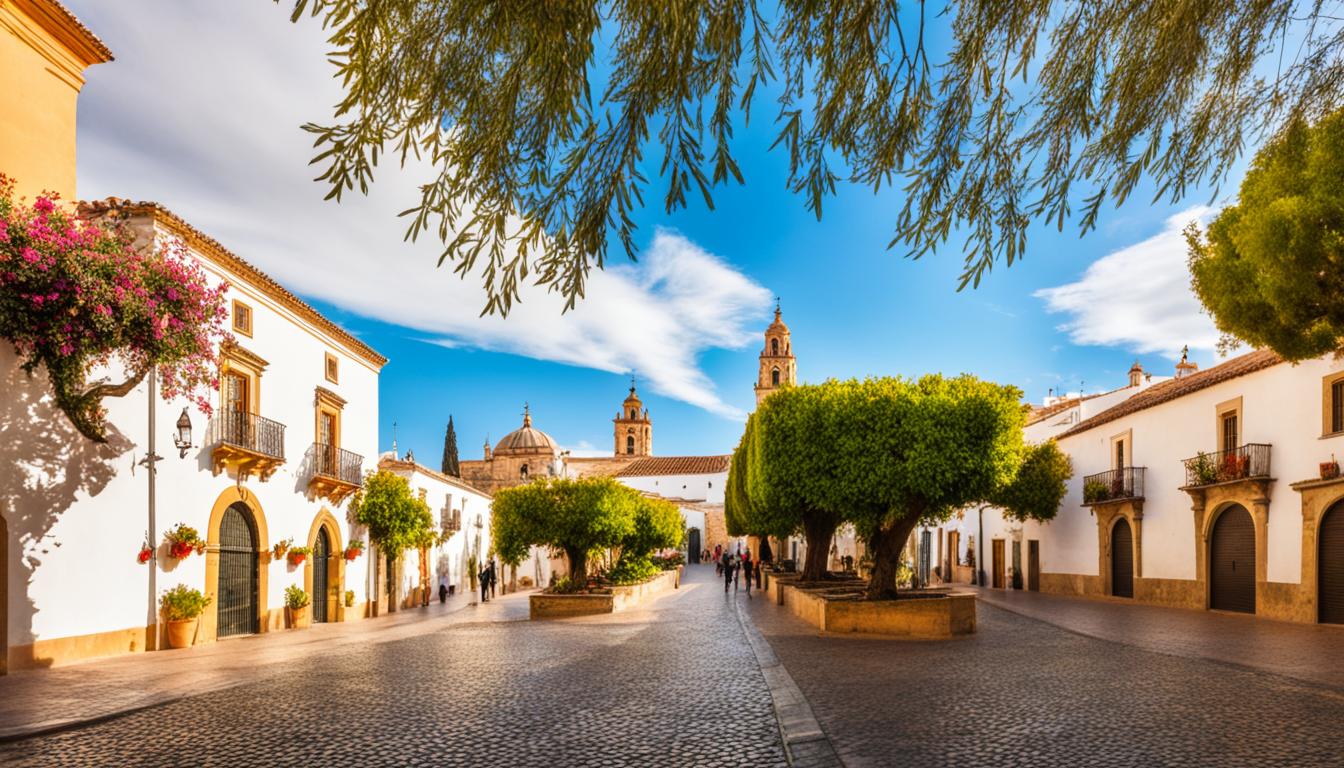Cordoba is a city where Moorish, Spanish, and Roman cultures meet. It invites visitors to dive into its rich history. The Cordoba Walking Tour takes you through major landmarks like the Mezquita and the Jewish Quarter.
There’s also the option to visit the Arabian Baths for a peaceful break. This tour is a journey through Cordoba’s past, showing its vibrant present.
Key Takeaways
- Discover the blend of Moorish, Spanish, and Roman influences in Cordoba, Spain
- Explore the city’s key landmarks, including the Mezquita, Jewish Quarter, and Alcázar de los Reyes Cristianos
- Upgrade your tour to include a relaxing Arabian baths experience at Baños Árabes de Córdoba
- Gain an in-depth understanding of Cordoba’s captivating history and cultural heritage
- Enjoy a professionally guided tour with multilingual commentary to cater to diverse participants
The Mezquita: A Marvel of Moorish Architecture
The Mezquita, also known as the Mosque-Cathedral of Córdoba, is a gem in this historic Spanish city. It dates back to the 8th century. This building shows the beauty of Moorish architecture that once flourished in Cordoba.
The Outer Walls and Patio de los Naranjos
When you get close to the Mezquita, its large stone walls grab your attention. It sits on a raised platform, looking both impressive and powerful. Inside the Patio de los Naranjos, you’ll find a peaceful garden courtyard.
It was once used for washing before prayers. Now, it’s filled with orange trees and birds singing sweet melodies.
The Intricate Interior and Mihrab Archway
Once inside, you’re surrounded by beautiful red and white arches. This is a hallmark of Moorish architecture. The Mihrab archway is especially striking, with a golden eight-pointed star dome above it.
There are also many scalloped arches and Christian chapels. They make the Mezquita’s inside design both complex and captivating.
The Mezquita is famous for its red-and-tan striped double arches. They’re held up by nearly a thousand pillars from ancient Roman ruins. This amazing sight goes on forever, leaving visitors in awe.
“The Mezquita is a stunning example of the blending of Islamic and Christian influences, showcasing the rich cultural heritage of Cordoba.”
Wandering Through the Jewish Quarter
In the heart of Cordoba lies the Juderia, or old Jewish Quarter. This area shows off the city’s Sephardic heritage. It has whitewashed buildings and shops, and is home to the Casa Sefarad. This museum tells the story of Spanish Jews.
Walking through the Cordoba Jewish Quarter feels like stepping back in time. You’ll see the Juderia district and its Sephardic heritage. The Hamam Al-Andalus spa is a big draw. It offers special tickets and a loyalty program across cities.
“The Jewish Quarter in Cordoba dates back to the medieval period, showcasing a history that spans over centuries. The expulsion of the Jewish community from Cordoba in 1492 marked a significant event in the quarter’s history.”
The Juderia shows off a mix of Gothic and Mudejar styles. This mix tells of a prosperous and vibrant past. Walking here, you’ll feel the strong traditions and community spirit.
Cordoba’s culture and literature shine in the Juderia district. Famous poets and thinkers like Ibn Zaydun and Wallada lived here. The walking tour shares stories of these great minds, adding depth to your visit.
Relaxing at the Baños Árabes de Córdoba
In the heart of Córdoba’s old town, the Baños Árabes de Córdoba offer a unique spa experience. These Moorish heritage sites let you travel back in time. They show off the area’s rich Arabic baths tradition.
An Intimate and Enchanting Spa Experience
When you walk into the Baños Árabes, you feel the calm right away. These Baños Árabes de Córdoba are different from the big, crowded baths. They have a special charm that makes you feel relaxed.
The main pool’s warm, mineral-rich waters are a highlight. The water’s high salt content lets you float and relax. It’s perfect for rejuvenating your body and mind.
The staff is very attentive, offering Moroccan mint tea for free. The Arabic baths feel even more special with soft music and water sounds. It’s a truly intimate and enchanting place.
If you want to escape the city or experience something unique, the Baños Árabes de Córdoba are perfect. They offer a relaxing spa experience that shows off Córdoba’s Moorish heritage. It’s a hidden treasure that will leave you feeling refreshed and connected to the city’s history.
Cordoba’s Archaeological Museum: A Treasure Trove of History
In the heart of Cordoba lies the Cordoba Archaeological Museum. It’s a place that takes you back in time. The museum is filled with local artifacts and has walls that tell their own stories of history.
The museum sits on what used to be a Renaissance palace. It showcases artifacts from 300,000 BC and more. In 2001, workers found an Ancient Roman Theatre during a building project. Instead of ignoring it, the museum added it to the exhibits, letting visitors see real Roman ruins.
Going down to the basement, you’ll see the Roman Theatre. It connects you to Cordoba’s past as a key Roman city. This exhibit highlights the city’s Roman heritage and the museum’s effort to keep ancient artifacts alive.

If you love history or just want to learn about Cordoba’s past, you must visit the Cordoba Archaeological Museum. You’ll be amazed by the mix of Renaissance architecture and Roman ruins. It’s a place that tells Cordoba’s incredible story.
Crossing the Roman Bridge and Puerta del Puente
The Roman Bridge in Cordoba, Spain, is a sight to behold. It stretches over the Guadalquivir River and has been around since the 1st century AD. This bridge has seen many years and still amazes people from all over.
When you get close, you’ll be amazed by its size and history. The bridge has 16 stone arches. It was crucial for connecting Cordoba to the other side of the river for a long time. It even appeared in the popular TV series Game of Thrones, making it even more famous.
At the bridge’s end is the Puerta del Puente, built in the 16th century. This beautiful gateway is now a historical monument. It shows off Cordoba’s deep history and culture.
| Fact | Value |
|---|---|
| Year the Puerta del Puente was constructed | 1571-1572 |
| Year Puerta del Puente was declared a historical-artistic monument | 1931 |
| Year Puerta del Puente was recognized as part of the Cordoba World Heritage site | 2008 |
| Entrance fee to visit Puerta del Puente | None |
Walking across the Roman Bridge, enjoying the river views, or exploring the Puerta del Puente will leave you in awe. This part of Cordoba is a must-see for anyone wanting to dive into its history and culture.
Alcázar de los Reyes Cristianos: A Moorish-Christian Fusion
The Alcázar de los Reyes Cristianos is right next to the famous Mezquita. It’s a 14th-century palace that mixes Spanish, Roman, and Arabic styles. You can see its beautiful gardens, marble sarcophagus, and well-kept Arabian baths. The baths show off Cordoba’s Moorish heritage with their detailed rooms and calm vibe.
Exploring the Palace’s Gardens and Baths
Walking through the palace, you can feel the history of the place. The Alcázar de los Reyes Cristianos, or Castle of the Christian Monarchs, was built in 1328 by King Alfonso XI. It was a home for Christian kings and a center for the Spanish Inquisition for over 300 years.
Now, the castle spans about 55,000 square meters and has towers, views of Cordoba, and a Moorish bath complex. You can see the Hall of Mosaics with Roman artifacts and the Renaissance-inspired gardens.
| Key Features | Ratings |
|---|---|
| Overall Tour Experience | 4.6/5 |
| Tour Guide Engagement | 4.8/5 |
| Value for Money | 4.4/5 |
| Organization and Efficiency | 4.6/5 and 4.7/5 |
Seeing the Alcázar de los Reyes Cristianos lets you dive into Cordoba’s Moorish-Christian architecture. It’s a place with preserved features and peaceful gardens. It shows off the city’s deep history and culture.

“The Alcázar de los Reyes Cristianos is a true gem, showcasing the remarkable fusion of Moorish and Christian influences that define Cordoba’s architectural legacy.”
The Caballerizas Reales: Home of the Andalusian Horse
In the heart of Cordoba, Spain, the Caballerizas Reales, or Royal Stables, celebrate the area’s equestrian past. Founded in 1570 by King Felipe II, they’ve been key in breeding the Andalusian horse. This breed is famous all over the world.
The stables have large, high ceilings held up by sandstone pillars. They’re split into smaller areas called “boxes.” Here, you can see the beauty and skill of these horses at the nightly Equestrian Show. This show mixes horse skills with flamenco and dance, leaving everyone amazed.
| Feature | Detail |
|---|---|
| Historical Significance | The Caballerizas Reales had many roles, like military quarters and places for farming experiments. |
| Architectural Grandeur | The main stable’s design, with its vaulted ceiling and sandstone pillars, shows its beauty. |
| Equestrian Shows | The nightly Equestrian Show at the Royal Stables of Cordoba blends horse skills, flamenco, and dance, wowing the crowd. |
| Visitor Experience | Guests can see the carriage museum, learn to ride horses, and watch the Andalusian horses in action. |
Since 1994, the Caballerizas Reales have been a UNESCO World Heritage Site. They’re a center for Andalusian horse breeding and celebrate the area’s equestrian history. If you love horses or just want to learn about Spain’s history, visiting the Caballerizas Reales in Cordoba is a must.
“The Andalusian horse, recognized since the 15th century, now numbers over 185,000 and is the preferred breed of nobility across Europe.”
Cordoba Spain Walking Tour: A Journey Through Time
Embark on a 3.5-hour walking tour in Cordoba, Spain, to uncover its deep history and culture. You’ll see how Spanish, Roman, and Arabic influences merged. Highlights include the famous Mezquita and the stunning Alcázar de los Reyes Cristianos.
Your tour starts in the historic center of Cordoba. Here, you’ll be amazed by the Mezquita’s detailed design. This place shows off the city’s Moorish past and its mix of Islamic and Christian styles.
Next, you’ll explore the Jewish Quarter. Walk through narrow streets and pretty squares that have been here for centuries. The tour ends at the Alcázar de los Reyes Cristianos, a Moorish fortress. Here, you can see beautiful gardens and ancient baths, diving deep into Cordoba’s history and architecture.

